| dc.contributor.author | Eriksen, Martin | |
| dc.date.accessioned | 2014-02-06T09:45:09Z | |
| dc.date.issued | 2012 | |
| dc.identifier.citation | Conf. to June 2014 | no_NO |
| dc.identifier.uri | http://hdl.handle.net/11250/183658 | |
| dc.description | Master's thesis in Petroleum engineering | no_NO |
| dc.description.abstract | A new petrophysical model on the Gyda field has been developed during 2011
and 2012 by Ian Reid of Petro CTS. This thesis studied the performance of
this on three well, and compared it to the old interpretation of the same
wells. The comparison was done by comparing porosity, permeability and
water saturation. The new model make use of active porosity, the fraction of
pore space contributing to production, to determine permeability and water
saturation from capillary pressure. The study shows that this gives a good
representation of the reservoir interval, as long as the zonation is correct.
The saturation height model also gives correct values as long as the Free
Water Level is set to the correct height. The model does not give accurate
saturation values close to the set Free Water Level.
The comparison showed very similar results between the old and new
model, deviation was small and went either way. | no_NO |
| dc.language.iso | eng | no_NO |
| dc.publisher | University of Stavanger, Norway | no_NO |
| dc.relation.ispartofseries | Masteroppgave/UIS-TN-IPT/2012; | |
| dc.subject | petroleumsteknologi | no_NO |
| dc.subject | reservoarteknologi | no_NO |
| dc.subject | petrophysics | no_NO |
| dc.title | Impact of new petrophysical model to the western flank of Gyda field - understanding of reservoir quality | no_NO |
| dc.type | Master thesis | no_NO |
| dc.subject.nsi | VDP::Technology: 500::Rock and petroleum disciplines: 510::Petroleum engineering: 512 | no_NO |
| dc.description.embargo | 2014-06-15 | |
